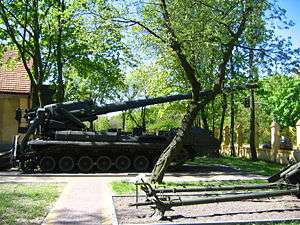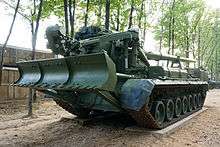2S7 Pion
| 2S7 Pion | |
|---|---|
 | |
| Type | Self-propelled artillery |
| Place of origin | Soviet Union |
| Service history | |
| In service | 1976 – present |
| Production history | |
| Produced | 1975 – 1990 |
| Specifications | |
| Weight | 46.5 tons |
| Length | 10.5 m (34 ft 5 in) |
| Width | 3.38 m (11 ft 1 in) |
| Height | 3 m (9 ft 10 in) |
| Crew | 7 |
|
| |
| Armor | 10mm max. |
Main armament | 203 mm 2A44 gun |
| Engine |
V-46-I V12 turbocharged diesel 840 hp |
| Suspension | torsion bar |
Operational range | Road: 650 km (400 mi) |
| Speed | 50 km/h (31 mph) |
The 2S7 Pion ("peony") or Malka is a Soviet self-propelled gun. "2S7" is its GRAU designation.
It was identified for the first time in 1975 in the Soviet Army and so was called M-1975 by NATO (the 2S4 Tyulpan also received the M-1975 designation), whereas its official designation is SO-203 (2S7). Its design is based on a T-80 chassis carrying an externally mounted 2A44 203 mm gun on the hull rear.
It takes the crew of seven men 5–6 minutes to come into action and 3–5 minutes to come out of action. It carries four 203 mm projectiles for immediate use. It is capable of firing nuclear ammunition. The gun has a range of 37,500 m, but this can be extended to 55,500 m by using RAPs (Rocket Assisted Projectiles). The Pion has been the most powerful conventional artillery piece since entering service in 1983. One interesting feature of the Pion is the firing alarm. Because the blast of the weapon firing is so powerful - it can physically incapacitate an unprepared soldier or crew member near it from concussive force - the Pion is equipped with an audible firing alarm that emits a series of short warning tones for approximately five seconds prior to the charge being fired.
The 2S7 carries a crew of fourteen; seven are carried by the Pion and seven are with an auxiliary vehicle. The system carries four rounds of ammunition; four more rounds are carried by the support vehicle. Due to the long range, the crew can fire one or two rounds and leave position before the first round hits the enemy position over 40km away. This makes the 2S7 less susceptible to return fire,[1] from an enemy with an anti-artillery system such as ARTHUR.
Operational History
The 2S7 was first used in combat by the Soviet Union in Soviet-Afghan War. Later, Russian forces used it in the First and Second Chechen Wars. The Georgian Army used 2S7s in the Russo-Georgian War in 2008, one of which was captured by Russian forces.
2S7s were brought back into service by the Ukrainian army during the War in Donbass in late 2014, and were used in combat just outside the 'buffer' zone stipulated by the Minsk Protocol, as they had long enough range to still provide artillery support.[2]
Variants
- 2S7 Pion
- 2S7M Malka - An improved variant, which entered service in 1983, that improved the gun's fire control systems, increased the rate of fire to 2.5 rounds per minute, and increased the ammunition load to eight projectiles.[3]
- BTM-4 Trench Digger.[4]
Operators
Although no figures have been released, it is estimated that well over 1,000 have been built.[5]
-
 Angola - 12; (Acquired in 2000 from the Czech Republic)[6]
Angola - 12; (Acquired in 2000 from the Czech Republic)[6] -
 Azerbaijan - 12; (3 acquired in 2008 and 9 acquired in 2009[7])
Azerbaijan - 12; (3 acquired in 2008 and 9 acquired in 2009[7]) -
 Belarus - 36
Belarus - 36 -
 Georgia [8][9]
Georgia [8][9] -
 Russia - 20 2S7M in active service[10][11]
Russia - 20 2S7M in active service[10][11] -
 Slovakia - 3; (1 used for testing, 2 military museum)
Slovakia - 3; (1 used for testing, 2 military museum) -
 Ukraine - 99, brought from reserve and restored to active service due to the War in Donbass.[12]
Ukraine - 99, brought from reserve and restored to active service due to the War in Donbass.[12] -
 Uzbekistan - 48
Uzbekistan - 48 -
 North Korea - unknown
North Korea - unknown
Former operators
-
 Soviet Union - Passed on to successor states.
Soviet Union - Passed on to successor states. -
 Czechoslovakia - 12 vehicles operated by 17th Large Caliber Artillery Division in Žamberk, 1984 - 1994.[13] One machine is kept in Military museum Lešany.
Czechoslovakia - 12 vehicles operated by 17th Large Caliber Artillery Division in Žamberk, 1984 - 1994.[13] One machine is kept in Military museum Lešany. -
 Poland - 8 guns. Military designation "Piwonia". Entered service in 1985 and withdrawn in 2006. Served first in the 5th Artillery Brigade in Głogów then with the 23rd Silesian Artillery Brigade in Bolesławiec.
Poland - 8 guns. Military designation "Piwonia". Entered service in 1985 and withdrawn in 2006. Served first in the 5th Artillery Brigade in Głogów then with the 23rd Silesian Artillery Brigade in Bolesławiec.

See also
References
- ↑ "2S7 Pion". Military Today.
- ↑ "2S7 Pion". War for Ukraine. Retrieved 2 April 2016.
- ↑ "Russian Military Forces - Aviation - Navy - Infantry firearms - Communications - Ground systems - Weapon photogallery". Retrieved 24 December 2014.
- ↑ "2S7 Pion". Military Today.
- ↑ Jane's Armour and Artillery 1997-98 ISBN 0-7106-1542-6
- ↑ http://portal.sipri.org/publications/pages/transfer/trade-register
- ↑ "Today.Az - What weaponry did Azerbaijan buy from Russia last year?". Retrieved 24 December 2014.
- ↑ "2S7 Pion". Military Today.
- ↑ http://www.armyrecognition.com/georgia/georgia_army_georgian_land_ground_forces_military_equipment_armoured_vehicles_pictures_information_d.html
- ↑ https://lenta.ru/news/2015/12/03/pion/
- ↑ http://bmpd.livejournal.com/2143111.html
- ↑ "Украина возвращает на вооружение мощнейшие САУ Пион: видео". Liga.
- ↑ History of 131th Artillery Division (in Czech)
External links
| Wikimedia Commons has media related to 2S7 Pion. |